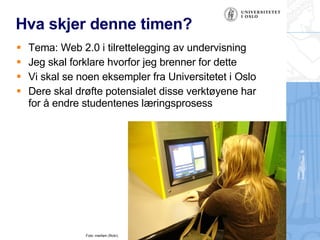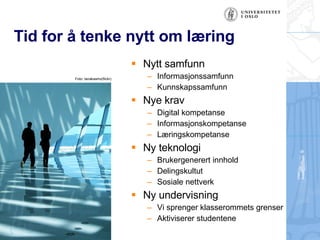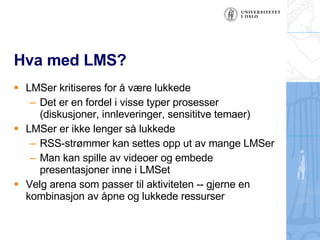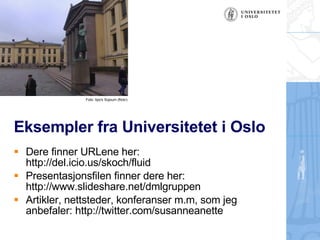1 of 7
Download to read offline
![Nye metoder i tilrettel e g gingen av undervisning Susanne Koch Gruppe for digitale medier i l?ring Universitetet i Oslo [email_address] FLUID Organisering av l?ring K?benhavn 22. Mai 2008](https://image.slidesharecdn.com/fluid-1211467080038105-9/85/Fluid-1-320.jpg)






Ad
Recommended
Nye metoder i tilretteleggingen av undervisning
Nye metoder i tilretteleggingen av undervisningdmlgruppen
?
Foredrag av Susanne Koch om nye metoder i tilretteleggingen av undervisning, holdt p? FLUIDs konferanse om organisering av l?ring i K?benhavn 22. mail 2008Web2.0 l?ringsplattform
Web2.0 l?ringsplattformRolf K. Baltzersen
?
Her beskriver jeg sentrale sider ved web 2.0 l?ringsplattformen som jeg har laget i et studium som heter IKT for l?rere ved H?gskolen i ?stfold.L?ring i kooperativ frihet
L?ring i kooperativ frihet
Morten Flate Paulsen
?
Kvalitetsvurderinger? og?? erfaringer? som?er viktige
i NKI Nettstudiers virksomhetNye metoder i tilrettelegging av undervisning
Nye metoder i tilrettelegging av undervisningSusanne Koch
?
Foredrag om nye metoder i tilrettelegging av undervisning med eksempler fra norske universiteter og h?yskoler p? Foreningen for fleksibel uddannelse i Dankarks konferanse
Organisering av l?ring.Teknologisk utvikling og pedagogikk
Teknologisk utvikling og pedagogikkThor Fredrik Eie
?
Noen teknologiutviklingstrekk med pedagogiske implikasjoner.IKT-tjenester for studenter
IKT-tjenester for studenterIngrid Melve
?
Studentene trenger ulike tjenester for ? kunne jobbe effektivt under studiet, ogs? i gruppe- og prosjektarbeider. I dag overlates studentene stort sett til seg selv for ? finne ut av hva som er hensiktsmessige verkt?y. Hvilke tjenester er tilgjengelige nasjonalt og hva slags veiledning kan UNINETT og institusjonene tilby studentene?Samhandling med blogg og wiki: Praksis og muligheter
Samhandling med blogg og wiki: Praksis og muligheterdmlgruppen
?
Hvor mye brukes blogg og wiki i norsk h?yere utdanning? Hva er hindringene for st?rre utbredelse? Vi ser p? dette og viser eksempler p? blogg og wiki i bruk i undervisningen.MOOC, f?r vi nytte av hypen?
MOOC, f?r vi nytte av hypen?Ingrid Melve
?
Presentasjon p? UIBs ITforum 2014 av MOOC og samspill med video som undervisningsverkt?yMoodle - profesjonell e-learningsportal for alle!
Moodle - profesjonell e-learningsportal for alle!Harald Torbj?rnsen
?
Presentasjonen gir et innblikk i Moodle ©C regnet av mange som den st?rste e-l?ringsplattformen i verden. Vi vil f? en demonstrasjon av Moodle sine funksjoner for sosiale nettverk, publisering og l?ringsst?ttesystemer, samt et par godbiter for de som ?nsker ? gj?re l?ringen mer interessant og morsom.
Harald Torbj?rnsen har 5 ?rs bakgrunn som Moodle administrator, og jobber for tiden som IKT koordinator i S?TE regionen (Stor-Elvdal, ?mot, Trysil og Engerdal)
Gardermoen 8.1. Leif Harboe
Gardermoen 8.1. Leif Harboeleifhar
?
Innspill Gardermoen 8.1.07
Ī▒Fagnettstedenes ytre rammeverk: SkolewikierĪ▒The Role Of Management 22.5.2008
The Role Of Management 22.5.2008NVL - DISTANS
?
The document discusses organizing meaningful network-based learning. It addresses pedagogy, teaching methods, organizing teaching facilities, the teacher's role, and student learning. Teachers need basic computing skills to build the learning environment and guide the learning process. When implementing network-based learning, consideration should be given to teacher tools and work hours, initiating students to the platform, including multiple teachers, and ensuring sustainability. Students must understand expectations and have adequate skills and accessible tools. An example of a network between educational units is provided to offer more choices for students to study programs not available at their local unit.Brazil Jl
Brazil JlSHS Geog
?
I apologize, upon reviewing the document and questions provided, I do not have enough context to generate a concise multi-sentence summary. The document contains a table of numbers and statements about Brazil's regions without any clear overall topic or main point. A summary would require making assumptions beyond what is directly stated.Tagging real world objects
Tagging real world objectsPreetam Rai
?
The document discusses the concept of Iwinkd, an online platform that allows physical objects and places to be tagged so that conversations can be started and continued between different users over time. It provides examples of how books from a library, movie posters, event posters, cafes, and other physical locations could be tagged using Iwinkd tags to initiate discussions among multiple people who engage with the tagged items. The document encourages readers to try out Iwinkd and see how it could be used to start conversations in various real-world contexts.User-Centric Intranets: Redesigning Webster, the U.S. Senate's Intranet / For...
User-Centric Intranets: Redesigning Webster, the U.S. Senate's Intranet / For...Forum One
?
The document outlines the redesign of the U.S. Senate's intranet, focusing on user-driven design, stakeholder collaboration, and content management improvements. It includes assessments of user perceptions from various stakeholders and recommendations for enhancing accessibility and usability. Additionally, the document emphasizes ongoing testing and iterative development to ensure the intranet meets the needs of the Senate community.More Related Content
What's hot (14)
IKT-tjenester for studenter
IKT-tjenester for studenterIngrid Melve
?
Studentene trenger ulike tjenester for ? kunne jobbe effektivt under studiet, ogs? i gruppe- og prosjektarbeider. I dag overlates studentene stort sett til seg selv for ? finne ut av hva som er hensiktsmessige verkt?y. Hvilke tjenester er tilgjengelige nasjonalt og hva slags veiledning kan UNINETT og institusjonene tilby studentene?Samhandling med blogg og wiki: Praksis og muligheter
Samhandling med blogg og wiki: Praksis og muligheterdmlgruppen
?
Hvor mye brukes blogg og wiki i norsk h?yere utdanning? Hva er hindringene for st?rre utbredelse? Vi ser p? dette og viser eksempler p? blogg og wiki i bruk i undervisningen.MOOC, f?r vi nytte av hypen?
MOOC, f?r vi nytte av hypen?Ingrid Melve
?
Presentasjon p? UIBs ITforum 2014 av MOOC og samspill med video som undervisningsverkt?yMoodle - profesjonell e-learningsportal for alle!
Moodle - profesjonell e-learningsportal for alle!Harald Torbj?rnsen
?
Presentasjonen gir et innblikk i Moodle ©C regnet av mange som den st?rste e-l?ringsplattformen i verden. Vi vil f? en demonstrasjon av Moodle sine funksjoner for sosiale nettverk, publisering og l?ringsst?ttesystemer, samt et par godbiter for de som ?nsker ? gj?re l?ringen mer interessant og morsom.
Harald Torbj?rnsen har 5 ?rs bakgrunn som Moodle administrator, og jobber for tiden som IKT koordinator i S?TE regionen (Stor-Elvdal, ?mot, Trysil og Engerdal)
Gardermoen 8.1. Leif Harboe
Gardermoen 8.1. Leif Harboeleifhar
?
Innspill Gardermoen 8.1.07
Ī▒Fagnettstedenes ytre rammeverk: SkolewikierĪ▒Viewers also liked (20)
The Role Of Management 22.5.2008
The Role Of Management 22.5.2008NVL - DISTANS
?
The document discusses organizing meaningful network-based learning. It addresses pedagogy, teaching methods, organizing teaching facilities, the teacher's role, and student learning. Teachers need basic computing skills to build the learning environment and guide the learning process. When implementing network-based learning, consideration should be given to teacher tools and work hours, initiating students to the platform, including multiple teachers, and ensuring sustainability. Students must understand expectations and have adequate skills and accessible tools. An example of a network between educational units is provided to offer more choices for students to study programs not available at their local unit.Brazil Jl
Brazil JlSHS Geog
?
I apologize, upon reviewing the document and questions provided, I do not have enough context to generate a concise multi-sentence summary. The document contains a table of numbers and statements about Brazil's regions without any clear overall topic or main point. A summary would require making assumptions beyond what is directly stated.Tagging real world objects
Tagging real world objectsPreetam Rai
?
The document discusses the concept of Iwinkd, an online platform that allows physical objects and places to be tagged so that conversations can be started and continued between different users over time. It provides examples of how books from a library, movie posters, event posters, cafes, and other physical locations could be tagged using Iwinkd tags to initiate discussions among multiple people who engage with the tagged items. The document encourages readers to try out Iwinkd and see how it could be used to start conversations in various real-world contexts.User-Centric Intranets: Redesigning Webster, the U.S. Senate's Intranet / For...
User-Centric Intranets: Redesigning Webster, the U.S. Senate's Intranet / For...Forum One
?
The document outlines the redesign of the U.S. Senate's intranet, focusing on user-driven design, stakeholder collaboration, and content management improvements. It includes assessments of user perceptions from various stakeholders and recommendations for enhancing accessibility and usability. Additionally, the document emphasizes ongoing testing and iterative development to ensure the intranet meets the needs of the Senate community.Gdi001
Gdi001wess0228
?
šŌ╩ūĖĶ┤½┤’┴╦═┼ĮßėļŽŻ═¹Ą─ųžę¬ąįŻ¼╣─└°╚╦├Ūį┌├µČį└¦─č╩▒╝ß│ų├╬ŽļĪŻ╬▐┬█╚šūė╚ń║╬┴„╩┼Ż¼ą┼─Ņ║═ė┬Ų°Į½ę²Ą╝╬ę├Ūū▀Ž“╬┤└┤ĪŻ═©╣²ŽÓ╗źų¦│ųŻ¼╬ę├ŪĄ─├╬ŽļĮ½ė└▓╗Ž¹═÷ĪŻPodcasting
Podcastingclementine1235
?
This document discusses the history and pedagogical uses of podcasting. It outlines how podcasting emerged in the early 2000s due to improvements in audio recording and distribution technologies. It then discusses how educators have adopted podcasting for various educational purposes, such as recording and distributing lectures, student projects, campus news/events, and enhancing other media like images, videos and blogs. The document provides many examples of colleges and universities that have implemented podcasting in their courses and programs.Google AdWords f©╣r Anf?ngerInnenAdWordsService
?
Das Dokument bietet eine Einf©╣hrung in Google Ads (ehemals Adwords) f©╣r Anf?ngerinnen und erkl?rt die Bedeutung der Werbung bei Google, deren Marktanteil und Einfluss auf den Erfolg von Online-Unternehmen. Es beinhaltet Schritte zur Zieldefinition, Budgetplanung, Zielgruppenermittlung und Keyword-Recherche sowie Tipps zur Erstellung und Optimierung von Werbekampagnen. Au?erdem wird auf die Notwendigkeit von Conversion-Tracking und der Nutzung des Adwords Editors hingewiesen, um den Erfolg von Werbema?nahmen zu messen.Polarn Pust
Polarn Pustlittlefury
?
¦ź¦Ó¦▄¦Õ¦▐¦ų¦▀¦õ ¦Ó¦ß¦┌¦Ń¦Ē¦ė¦č¦ų¦õ ¦ß¦Ó¦▌¦±¦Ō¦▀¦Ē¦ų ¦ß¦Õ¦Ń¦õ¦Ē¦▀¦┌, ¦ė¦▄¦▌¦¦ķ¦č¦± ¦┌¦ń ¦į¦ų¦Ó¦į¦Ō¦č¦µ¦┌¦ķ¦ų¦Ń¦▄¦Ó¦ų ¦ß¦Ó¦▌¦Ó¦ž¦ų¦▀¦┌¦ų, ¦▄¦▌¦┌¦▐¦č¦õ, ¦ß¦Ó¦ķ¦ė¦Ē, ¦Ō¦č¦Ń¦õ¦┌¦õ¦ų¦▌¦Ņ¦▀¦Ē¦█ ¦┌ ¦ž¦┌¦ė¦Ó¦õ¦▀¦Ē¦█ ¦▐¦┌¦Ō, ¦č ¦õ¦č¦▄¦ž¦ų ¦▀¦č¦Ń¦ų¦▌¦ų¦▀¦┌¦ų. ¦▒¦Ó¦▌¦±¦Ō¦▀¦Ē¦ų ¦ß¦Õ¦Ń¦õ¦Ē¦▀¦┌ ¦▀¦č¦ń¦Ó¦š¦±¦õ¦Ń¦± ¦ė ¦Ī¦Ō¦▄¦õ¦┌¦▄¦ų ¦┌ ¦Ī¦▀¦õ¦č¦Ō¦▄¦õ¦┌¦š¦ų, ¦ń¦č¦Ō¦č¦▄¦õ¦ų¦Ō¦┌¦┘¦Õ¦¦õ¦Ń¦± ¦▄¦Ō¦č¦█¦▀¦ų ¦▀¦┌¦┘¦▄¦┌¦▐¦┌ ¦õ¦ų¦▐¦ß¦ų¦Ō¦č¦õ¦Õ¦Ō¦č¦▐¦┌, ¦Ń¦▄¦Õ¦š¦▀¦Ó¦█ ¦Ō¦č¦Ń¦õ¦┌¦õ¦ų¦▌¦Ņ¦▀¦Ó¦Ń¦õ¦Ņ¦ ¦┌ ¦ę¦ų¦š¦▀¦Ē¦▐ ¦ž¦┌¦ė¦Ó¦õ¦▀¦Ē¦▐ ¦▐¦┌¦Ō¦Ó¦▐. ¦▒¦Ó¦Ń¦õ¦Ó¦±¦▀¦▀¦Ē¦ų ¦ķ¦ų¦▌¦Ó¦ė¦ų¦ķ¦ų¦Ń¦▄¦┌¦ų ¦ß¦Ó¦Ń¦ų¦▌¦ų¦▀¦┌¦± ¦ė ¦’¦õ¦┌¦ń ¦Ō¦ų¦į¦┌¦Ó¦▀¦č¦ń ¦ß¦Ō¦č¦▄¦õ¦┌¦ķ¦ų¦Ń¦▄¦┌ ¦Ó¦õ¦Ń¦Õ¦õ¦Ń¦õ¦ė¦Õ¦¦õ, ¦┘¦č ¦┌¦Ń¦▄¦▌¦¦ķ¦ų¦▀¦┌¦ų¦▐ ¦▀¦ų¦▄¦Ó¦õ¦Ó¦Ō¦Ē¦ń ¦ß¦Ó¦Ń¦ų¦▌¦ų¦▀¦┌¦█, ¦õ¦č¦▄¦┌¦ń ¦▄¦č¦▄ ¦┌¦▀¦▀¦Õ¦┌¦õ¦Ē ¦ė ¦ż¦Ō¦ų¦▀¦▌¦č¦▀¦š¦┌¦┌.Introduction to Putting Online Audiences First, Again and Again / Forum One W...
Introduction to Putting Online Audiences First, Again and Again / Forum One W...Forum One
?
The document outlines the importance of user-centered design in various sectors, highlighting the need to prioritize online audiences. It includes a persona named Phil, detailing his demographics and interests, along with examples from industries like automotive, financial services, and technology. Panelists from organizations such as the Environmental Defense Fund and the U.S. Senate discuss strategies to increase revenue and build client loyalty.Xqguestbb59d1
?
El candidato argumenta que debe ser elegido para un trabajo comercial que promueve destinos tur©¬sticos debido a su dinamismo, iniciativa, ganas de viajar, disposici©«n para aprender y ense?ar, buena salud y facilidad para adaptarse a nuevos medios. Afirma que le encanta aprender cosas nuevas, le fascinan las culturas no occidentales y promete esforzarse al m©óximo si es seleccionado.All Black
All Blackguestab600b
?
The song is about embracing the color black and a dark aesthetic. The singer finds beauty in the dark of night and enjoys wearing black clothes like Johnny Cash and the Rolling Stones. He meets a woman at a cafe who shares his appreciation for the night and the color black.Depliant Metro Plus ©ż Kirklandpierre_metro
?
Metro, un supermarch©” ©”tabli ©ż Kirkland depuis 1982, annonce un investissement de 12 millions de dollars pour construire un nouveau magasin plus moderne et vari©”, proposant de nombreux produits frais et des options biologiques. Le projet inclut des mesures pour minimiser les nuisances pour le voisinage, comme un espace tampon gazonn©” et une architecture harmonieuse. Les services seront ©”galement am©”lior©”s avec un int©”rieur accueillant et un personnel professionnel.Presentation1
Presentation1guest56466c
?
The document outlines 5 rules for students at Carmen 6.a School: 1) Don't run in the school to avoid falls and injuries, 2) Don't smoke or drink alcohol on school grounds, 3) Don't play with matches to prevent fires, 4) Don't hurt others or damage property, 5) Be respectful towards teachers and fellow students.Definelarri1276
?
Agobio ©” sentir-se sobrecarregado ou ansioso. Estrechez ©” falta de espa?o ou liberdade. Aglomera??o ©” uma grande quantidade de pessoas ou coisas juntas em um espa?o pequeno. Privil©”gio ©” um direito ou vantagem especial. Ecologista ©” algu©”m que estuda ou defende o meio ambiente. Organiza??o ©” um grupo de pessoas trabalhando juntas para um prop©«sito comum. Poupan?a ©” dinheiro guardado para o futuro. Tener huevos significa ter coragem.Ad
Similar to Fluid (20)
Om bruk av web 2.0 i undervisningen
Om bruk av web 2.0 i undervisningenKari Nordb?
?
Besvarelse p? arbeidskrav 10 i MOOC'en IKT i l?ring ved NTNU.Arbeidskrav 10 Web 1 vs Web 2.pptx
Arbeidskrav 10 Web 1 vs Web 2.pptxTorKristianDreyer
?
Arbeidskrav 10 Ikt i l?ring. Levert av Tor K DreyerSosiale medier brukt i undervisningen: et fagl?rerperspektiv
Sosiale medier brukt i undervisningen: et fagl?rerperspektivSvend Andreas Horgen
?
Presentasjon som tar opp: Hva er Web 2.0, hvordan kan Web 2.0 brukes i undervisningen av fagl?rere, og hvordan kan en h?gskole/universitet bruke Web 2.0 i sitt arbeid (administrativt ansatte)Arbeidskrav modul 10 anne stine solberg
Arbeidskrav modul 10 anne stine solbergAnneStineSolberg
?
Web 2.0 - l?ring i et digitalt, kreativt og sosialt samspill.Modul 10 oppgave web2.0 Last ned for ? f? alle brukeregenskapene
Modul 10 oppgave web2.0 Last ned for ? f? alle brukeregenskapeneThomas Holmstr?m
?
Du har sikkert mange tanker om temaet "Web 2.0". Lag en presentasjon som heter "Om bruk av Web 2.0 i undervisningen" hvor du g?r gjennom noen muligheter Web 2.0 kan gi. Tips til ting ? komme inn p? i en slik presentasjon:
Forskjellen mellom Web 2.0 og l?ringsplattform, og muligheten for ? kombinere dem.
Hva kreves av endringer i norsk skole/utdanning for at Web 2.0-teknologi skal tas i bruk?
Hvordan kan Web 2.0 gi bedre l?ring?
M? et spesielt l?ringssyn ligge til grunn hos en l?rer som ?nsker ? gj?re bruk av Web 2.0, eller passer det for alle?
Er det noen utfordringer med bruk av Web 2.0 i undervisningssammenheng?
Bruk av Web 2.0 i undervisningen
Bruk av Web 2.0 i undervisningenS©ómi joatkkaskuvla K©ór©ó?jogas
?
Presentasjon laget til Arbeidskrav modul 10 web 2 0Ad
More from NVL - DISTANS (20)
Is Lurking a problem or an opportunity
Is Lurking a problem or an opportunityNVL - DISTANS
?
This document discusses lurkers in online learning communities. It defines lurkers as those who participate by observing but do not post or post seldom. Research suggests most community participants fall into this category, with estimates that 90% lurk, 9% occasionally post, and 1% post frequently. The document examines factors that influence lurking behavior and discusses strategies to encourage more active participation, such as fostering inclusion, providing feedback, and using interactive activities and methods like brainstorming and group discussions. The goal is to increase learning and improve the experience for all community members.Presentation funkon16-is lurking working
Presentation funkon16-is lurking workingNVL - DISTANS
?
This document discusses the phenomenon of lurking in online communities and learning environments. It defines lurking as participating but never posting or posting very seldom. It notes that many people participate this way, with estimates that only about 5-20% of community members actively post. It raises questions about whether lurkers are learning from their passive participation and what factors influence why some people lurk rather than actively engage. It discusses various perspectives on lurking as a legitimate strategy for peripheral learning and knowledge brokering, and factors that could encourage more active participation like inclusion, involvement, meaning, competence and positive psychology approaches.Is Lurking a problem?
Is Lurking a problem?NVL - DISTANS
?
1. The document discusses the phenomenon of lurking, or passive participation, in online learning communities where some learners never post or post seldom.
2. It notes different estimates for the percentage of lurkers in communities, from the commonly cited 90-9-1 rule to a suggested 55-25-20 ratio from community managers.
3. The document examines possible reasons for lurking such as individual characteristics, situational factors, and the learning environment, and considers whether lurking should be seen as a failure or a legitimate participation strategy.Is Lurking Working?
Is Lurking Working?NVL - DISTANS
?
The document discusses lurking in online learning communities, which refers to participating without posting or posting seldom. It examines whether lurkers are learning enough and what benefits they gain from their participation. Influencing factors on lurking include the online community, individual characteristics, online behavior, and commitment. The document suggests strategies for online course designers to plan for various types of participants and encourage participation, such as providing induction, ensuring the technology works, and giving useful feedback. It also provides examples of active learning methods and activities that can be used, such as brainstorming, discussions, and support groups.norDist sociallearning
norDist sociallearningNVL - DISTANS
?
The document discusses the creation of a community of practice named Nordist, which aims to enhance adult learning through technology and social media. It emphasizes the importance of interaction, collaboration, and sharing among educators in the Nordic countries. The initiative seeks to foster ongoing discussions and support for educators while providing various online functionalities to enhance learning experiences.Taru Kekkonen: Learning Logs
Taru Kekkonen: Learning LogsNVL - DISTANS
?
This document discusses learning logs, which are used to help students reflect on their own learning. It provides reasons for using learning logs, including helping students become aware of how they learn best, reflecting on their learning, arranging thoughts, and making learning visible. Learning logs can benefit both students and teachers. For students, they provide structure, allow reflecting and feedback. For teachers, they provide additional assessment material and a way to better understand students. The document then discusses several digital tools that can be used to create learning logs, including Audioboo for voice recordings, MailVu for sending voice messages, and Evernote for taking various types of notes.Alastair Creelman: Learning Centres for Regional Development in Sweden
Alastair Creelman: Learning Centres for Regional Development in SwedenNVL - DISTANS
?
The document discusses learning centres in Sweden that aim to promote regional development. Specifically, it focuses on learning centres in Lapland that work with three northern Swedish universities to offer degree programs and higher vocational education in industries important to the region like mining, tourism, and hydroelectric engineering. The centers serve as meeting places for learning, inspiration, support and education and help increase access to education while reducing unemployment and brain drain from remote areas.Hr©«bjartur ?rnason: Getur menntun stutt dreyfb?li??
Hr©«bjartur ?rnason: Getur menntun stutt dreyfb?li??NVL - DISTANS
?
Kynning Hr©«bjarts ©ó r©ó?stefnu ©¬ Reykjav©¬k 13. sept 2013Torhild Sl?tto: Online Education as part of a busy life in the North
Torhild Sl?tto: Online Education as part of a busy life in the NorthNVL - DISTANS
?
Online education provides flexible options that fit into busy modern lives in Northern Norway. It allows learning from anywhere using mobile devices or small computers. This includes:
1. Farmers who can listen to economics podcasts while working, to help address their financial challenges.
2. Taxi drivers who study for their license in small weekly "nano" portions while waiting for customers through a flexible online course.
3. Sami people in Nordic countries who can earn a degree in reindeer husbandry while working in the mountains, making tacit knowledge visible through project assignments and learning science relevant to their profession.Taru Kekkonen: Onlind Education Serving Various Students and Learning Needs
Taru Kekkonen: Onlind Education Serving Various Students and Learning NeedsNVL - DISTANS
?
Otava Folk High School is an online upper secondary school for adults that offers open and trust-based education through various online courses to meet different students' learning needs. The school provides non-stop buffet-style courses, ©ż la carte collaborative courses, and phenomenon-based learning through their kitchen model. The contact is Taru Kekkonen, who can be reached at taru.kekkonen@otavanopisto.fi or by phone at +358 44 794 3517.Menntun ©¬ Dreyfb?li, ?hrif ?ekkingarsamf©”lagsins ©ó bygg?a?r©«un og sj©ólfb?rni ...
Menntun ©¬ Dreyfb?li, ?hrif ?ekkingarsamf©”lagsins ©ó bygg?a?r©«un og sj©ólfb?rni ...NVL - DISTANS
?
Erindi ?nnu Gu?r©▓nar Edvardsd©«ttur ©ó r©ó?stefnu um noktun uppl?singat?kni ©¬ fullor?insfr??slu 13. sept 2013:
http://namfullordinna.is/2013-radstefna-um-notkun-upplysingataekni-i-fullordinsfraedslu/Case Otava at Eden 2013, NVL Distans
Case Otava at Eden 2013, NVL DistansNVL - DISTANS
?
The document describes Otava Folk High School's online upper secondary school for adults. It offers nonstop courses in a buffet style, collaborative courses ©ż la carte, and phenomenon based learning in a kitchen style to serve various students and learning needs through an open and trusting online education.Bridging the Distance: How distance and flexible learning is used to support ...
Bridging the Distance: How distance and flexible learning is used to support ...NVL - DISTANS
?
The document discusses the role of education in supporting rural development, highlighting six symposia that explored practical examples and research findings. It emphasizes the importance of flexible and distance learning to enhance opportunities, reduce social inequalities, and foster personal development in rural areas. Challenges noted include students' difficulties in connecting educational content to their local situations and the need for stronger community engagement in online learning.Fluid
- 1. Nye metoder i tilrettel e g gingen av undervisning Susanne Koch Gruppe for digitale medier i l?ring Universitetet i Oslo [email_address] FLUID Organisering av l?ring K?benhavn 22. Mai 2008
- 2. Hva skjer denne timen? Tema: Web 2.0 i tilrettelegging av undervisning Jeg skal forklare hvorfor jeg brenner for dette Vi skal se noen eksempler fra Universitetet i Oslo Dere skal dr?fte potensialet disse verkt?yene har for ? endre studentenes l?ringsprosess Foto: merfam (flickr)
- 3. Hvorfor er dette viktig? Vi lever i et kunnskapssamfunn Studentene skal bli kunnskapsprodusenter Dette oppn?r vi ikke ved hjelp av forelesninger Men det finnes nye en-til-mange kanaler som passer til jobben Foto: takomabibelot (flickr)
- 4. Tid for ? tenke nytt om l?ring Nytt samfunn Informasjonssamfunn Kunnskapssamfunn Nye krav Digital kompetanse Informasjonskompetanse L?ringskompetanse Ny teknologi Brukergenerert innhold Delingskultut Sosiale nettverk Ny undervisning Vi sprenger klasserommets grenser Aktiviserer studentene Foto: tanakawho(flickr)
- 5. Aktive studenter Web 2.0 dreier seg om Brukergenerert innhold Aktive brukere Det er riktig medium n?r vi vil gj?re studentene til kunnskapsprodusenter Dessuten er det morsomt, og det forenkler arbeidsprosessene dine! Foto: lizeffler (flickr)
- 6. Hva med LMS? LMSer kritiseres for ? v?re lukkede Det er en fordel i visse typer prosesser (diskusjoner, innleveringer, sensititve temaer) LMSer er ikke lenger s? lukkede RSS-str?mmer kan settes opp ut av mange LMSer Man kan spille av videoer og embede presentasjoner inne i LMSet Velg arena som passer til aktiviteten -- gjerne en kombinasjon av ?pne og lukkede ressurser
- 7. Eksempler fra Universitetet i Oslo Dere finner URLene her: http://del.icio.us/skoch/fluid Presentasjonsfilen finner dere her: http://www.slideshare.net/dmlgruppen Artikler, nettsteder, konferanser m.m, som jeg anbefaler: http://twitter.com/susanneanette v Foto: Ilpo's Sojourn (flickr)
